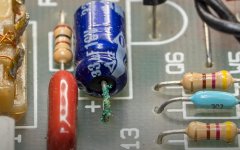Adjusting the head is in most cases not necessary.
Make sure your drive is complete: check that the pressure pad is still there. Without that, the drive will never work.
Here's how to clean and lubricate the drive.
- Remove the complete top assembly that holds the floppy disc ( release the lever from the eject motor )
- The mechanism will be completely stuck due to old grease that has hardened. Soack the assembly in WD40 for a few hours or if you have the WD40 Spray: spray all the moving parts multiple times, leaving 1/2 hour between treatments, until you can move the mechanism again.
Patience is the issue: do not try to move the mechanism with force, wait until the WD40 has solved all the old grease and dust.
- Once the mechanism is moving smoothly again, then clean all the WD40 from the assembly.
- Lubricate all the moving parts with a small amount of white lithium grease
- Now is a good time to clean the Head: clean it with at least 99% pure Isoprophyl Alcohol.
- Mount the assembly back on the drive and re-connect the lever to the eject motor.
Now try test the drive. First verify that all parts work. Insert a Double Density disc and see if the main motor spins the disc and the head moves.
Also try the eject mechanism.
If everything works, then mount the drive back in it's enclosure ( external is best to test ) and connect the earth wire.
Now try to initialize the floppy disc: If it formats without bad sectors, then the drive is repaired.
If not then inspect the head under a magnifying glass: it it's scratched or damaged then it's beyond repair.
Otherwise you have to adjust the head.
Look at your floppy disk for damage: if the head pushes too much on the floppy disc, then you will see circle scratches on the disc.
Best practice is to set the head as low as possible and keep trying until you can initialize your floppy disc without problems.
For adjusting the head, you needs to remove the PCB at the bottom to get to the screw.
You can find a detailed explanation here:
http://lowendmac.com/tech/after.html
I would not recommend to turn the screw fully clockwise, but do it with little steps of 1/4 turn clockwise until it works.
I know it's a time consuming job, these 400K drives always are....
Good Luck,
Nico

